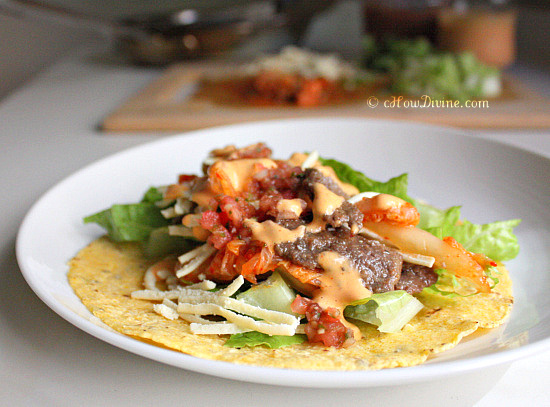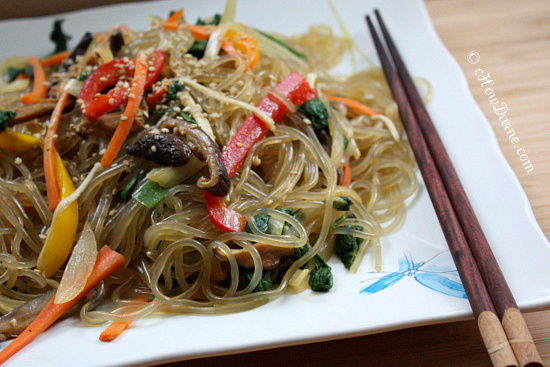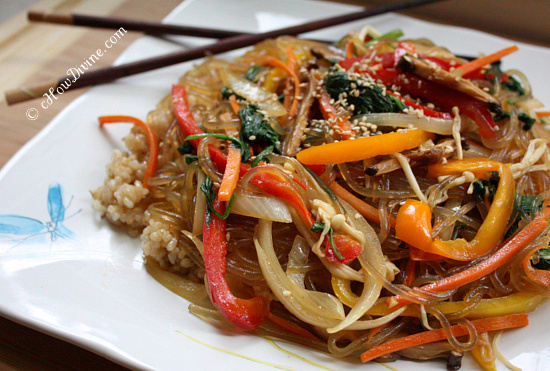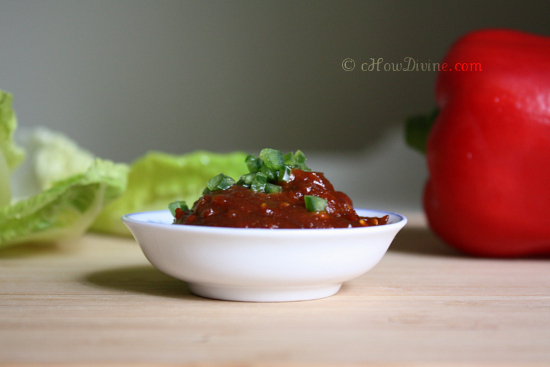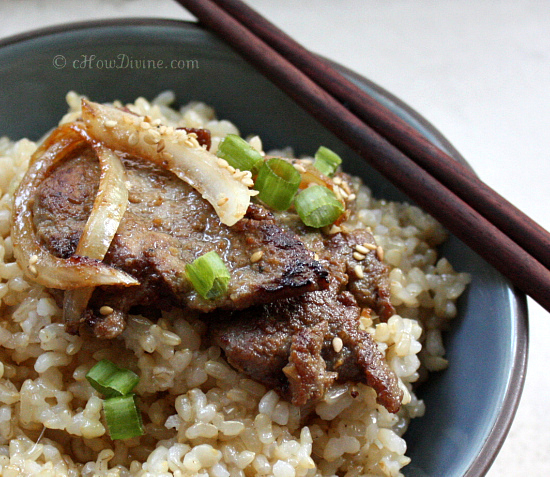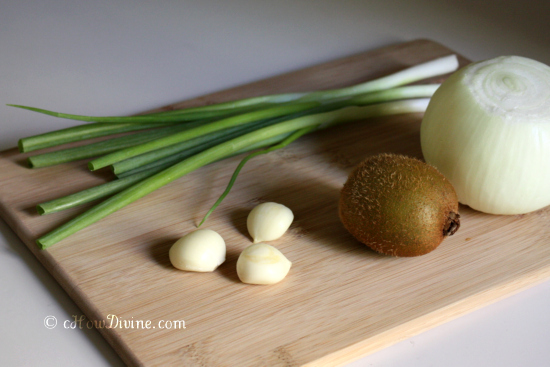My husband had some kind of a stomach bug. And he hadn’t been able to eat much of anything. I remembered whenever I had a stomach ache, my grandmother used to make me jook (porridge). I had some pine nuts on hand. And pine nuts are gluten-free and rich in nutrients; the hubs was really in need of some nutrients after 2 days of very little food. So I decided to make some jaht jook – pine nut porridge – a delicious, gluten-free, vegan dish.
Bulgogi Kimchi Taco à la Korilla BBQ
I don’t know one Korean who doesn’t like Mexican food. (OK, I’m sure there is at least one; I just personally don’t know one.) Even my mom who isn’t crazy about non-Asian cuisines loves Mexican food. There is just something about the cuisine that suits the Korean palate. I guess pico de gallo, salsa, and pickled jalapenos are akin to the Korean kimchi; and they balance out the richness that may be overwhelming for some.
But have you tried Korean-infused Mexican food? It’s truly delectable! Top your burrito or taco with some gochujang sour cream or guacamole; add some kimchi and bulgogi to burritos, tacos, or quesadillas; stir in some sautéed kimchi in some Mexican rice; and so on. Exceptionally delicious!
Vegetable Japchae
Is it wrong to treat your husband like a 5-year-old?
My husband doesn’t like to try new things. He says he doesn’t like something if he has never tried it or heard of it. Does it sound familiar moms and dads? It’s kind of like watching a toddler look at new food, smell it, put it in his mouth, take it out again, and frown.
I love japchae. I grew up with it. It was always made for birthdays because it symbolizes long life and prosperity. And it is absolutely delicious. My husband hates it. He didn’t grow up with it. His mother never made it. Now, he thinks it looks slimy and slippery. And he thinks it will make him queasy. Really?! How old are you?!
I hear that a toddler must try a new food about 8-15 times before the toddler knows if he likes it or not. I think I’m going to test that theory on my husband. Today, I made japchae for the first time since we got married. I am determined he will try it. And I will keep making it. After about 8 times – if he still hates it – I will let him be… (Update: My husband LOVED it.)
Japchae is usually made with sweet potato noodles. And if you’ve had it in a restaurant, it comes stir-fried on top of rice. But there is a bit of irony to the name “japchae” as it literally means mixture (“jap”) of vegetables (“chae”); and in its original form, japchae didn’t include noodles at all. I’ve had some varieties without noodles. But in my opinion, they don’t come close in taste to the noodle variety.
Ssamjang (Gochujang-Doenjang Sauce for Wraps)
Ssamjang directly translates to wrap sauce or wrap paste in Korean – “ssam” means wrap and “jang” means sauce or paste. Just as the name suggests, it’s a condiment commonly used when assembling Korean wraps. It is usually made with gochujang (Korean chili pepper paste) and doenjang (Korean soybean paste) as its base. But there are no rules when it comes to ssamjang. You can add anything to your heart’s desire. I’ve seen it made with lots of garlic, cooked minced meat, chopped sautéed mushrooms, crushed tofu, and so on. You can go wild. Really.
I had some marinated bulgogi in the refrigerator. And I was really craving some ssam (Korean lettuce wrap). I could have had it with gochujang sauce, but I wanted something different – a new treat for my palate. I decided to make some ssamjang.
I love garlic, roasted or sautéed/grilled garlic in particular. So I decided to make the ssamjang with some sesame oil-sautéed minced garlic. And I upped the garlic quotient by sautéing some sliced garlic for additional topping for my ssam. The result? Sublime…
Continue Reading Ssamjang (Gochujang-Doenjang Sauce for Wraps) . . .
Bulgogi (Korean Beef Barbecue)
I grew up eating bulgogi (a.k.a. Korean BBQ or Korean Barbecue) on a regular basis. It was a mainstay at family dinners, picnics, community gatherings, and so on. Sometimes we would barbecue bulgogi using charcoal. Sometimes we would cook it on a stove top using a pan. And other times, we would eat it as a stew with a little bit of broth. No matter the situation or the method of preparation, it was always so delicious and satisfying.
Admittedly, I don’t eat bulgogi nearly as much I used to. But I still enjoy it whenever I have it. I am also a little more health conscious than I used to be. So I no longer go on the carnivorous binges I used to. And I try to make healthier versions of my childhood dishes without sacrificing the taste.
Bulgogi is usually made with very thinly-sliced rib eye steak. But I decided to make a healthier(not to mention much more economical) version of the dish by using grass-fed eye round steak. Eye round is a much leaner cut than rib eye. Rib eye comes from the underbelly, the site of the fattiest cuts. And the eye round comes from the back leg area, the site of the leanest cuts; however, eye round can be very tough because it has virtually no fat. But it works for this dish because the eye round is cut into very thin slices and also marinated. Just as insurance, I am also adding a kiwi to tenderize the meat. Raw kiwi is rich in actinidin, a protein-dissolving enzyme. Useful as it is, kiwis can make meat mushy. So you need to be careful when using it in a marinade. A little goes a long way (very quickly).
I’ve been laid out by a cold for over a week. And I’ve been subsisting on soups to nurse my sore throat. When I was finally ready to reintroduce some solids into my diet, bulgogi seemed like the perfect choice. I figured lean protein and the iron should do me some good while the flavor satisfies my taste buds. And it really hit the spot. I was so pleasantly surprised by the texture and the taste of this dish. It was healthy and tasted so very decadent.


